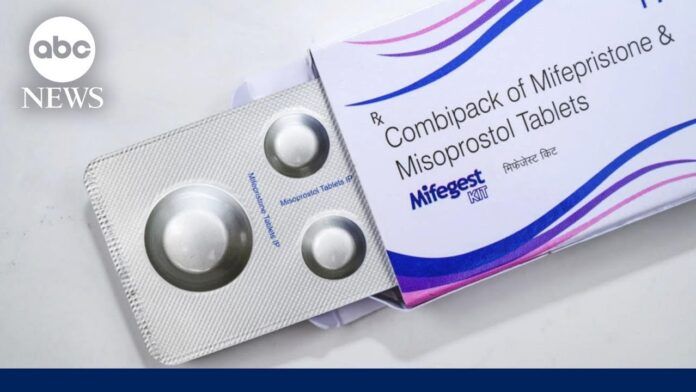The high court’s decision on mail-order abortion pills could significantly impact reproductive healthcare and legal standards nationwide
In an unprecedented legal battle with far-reaching implications, the United States Supreme Court is currently deliberating over the future of mifepristone access, a medication critical to providing abortion services across the nation. This case, emerging as the first significant abortion-related issue the Court has addressed since overturning Roe v. Wade, scrutinizes the Food and Drug Administration’s (FDA) regulatory decisions regarding the drug’s distribution and use. With the backdrop of a politically charged atmosphere following the landmark 2022 decision, the outcome of this case holds the potential to dramatically alter the landscape of reproductive healthcare in America. Mifepristone, when used in conjunction with misoprostol, constitutes a cornerstone of medication-induced abortions, representing nearly two-thirds of all such procedures in the country. Advocates argue that restricting access to mifepristone would not only undermine women’s healthcare but also challenge the scientific authority of federal agencies like the FDA. Opponents, however, question the FDA’s approval process and advocate for tighter controls, citing concerns over safety and the sanctity of life. As the nation watches, the Supreme Court’s ruling will undoubtedly have profound effects on the legal precedents governing reproductive rights and the regulatory powers of federal health agencies.
The Economist
The Economist article emphasizes the vital role of mifepristone in providing a safe, effective, and less invasive alternative to surgical abortions. Highlighting the drug’s significance, the piece notes that medication abortions, primarily facilitated by mifepristone, now account for a substantial majority of abortion procedures in the United States. The article critiques the legal challenge against the FDA’s approval of mail-order mifepristone as both medically and legally unfounded. It argues that imposing further restrictions on mifepristone would not only be detrimental to women’s health by limiting access to safe abortion options but also undermine the FDA’s authority to regulate based on scientific evidence. The Economist voices concern over the potential legal repercussions of siding with the plaintiffs, suggesting that it could set a dangerous precedent for future regulatory challenges, far beyond the realm of reproductive health. The publication advocates for a unanimous decision by the Supreme Court in favour of the FDA, emphasizing the importance of maintaining evidence-based regulation in the face of ideologically motivated legal challenges.
The Guardian
The Guardian’s coverage focuses on the human impact of the Supreme Court’s impending decision, particularly on those in areas where abortion access was already limited before the potential tightening of mifepristone regulations. It shares poignant stories from healthcare providers in Hawaii, illustrating the essential nature of mifepristone in extending abortion services to remote or underserved regions. The article sheds light on the dire consequences of restricting mifepristone access, including increased logistical and financial burdens on individuals seeking abortions. The Guardian emphasizes the broader implications of the case, suggesting that a decision to restrict access to mifepristone could not only roll back the advancements made in reproductive healthcare but also disproportionately affect the most vulnerable populations. The piece underscores the critical role of telemedicine and mail-order services in ensuring continued access to abortion pills, especially during the COVID-19 pandemic, and warns against the dangers of legal decisions that disregard medical evidence and patient needs.
Time
Time magazine offers an analysis of the legal and political stakes of the Supreme Court case on mifepristone, situating it within the wider context of the ongoing battle over reproductive rights in the U.S. The article examines the potential for the Court’s decision to radically restrict access to mifepristone, even in states where abortion remains legal, thereby affecting millions of American women. Time highlights the significance of medication abortions in the current healthcare landscape, where such procedures have become increasingly common and are deemed safe by numerous studies. The coverage also delves into the arguments presented by both sides of the case, noting the plaintiffs’ challenge to the FDA’s approval process and the defence of mifepristone’s safety and efficacy by medical professionals and reproductive rights advocates. Time underscores the importance of this case not only in determining the future of abortion access but also in shaping the legal framework for regulating medical treatments in the United States.
CNN
CNN’s report provides a comprehensive overview of the Supreme Court case on mifepristone, tracing the drug’s history, its approval by the FDA, and the subsequent legal challenges it has faced. The article highlights the importance of mifepristone in the landscape of reproductive healthcare, noting its safety, efficacy, and the critical role it plays in medication abortions. CNN’s coverage also details the specific regulatory changes under scrutiny in the case, such as the allowance for mail-order distribution and telemedicine prescriptions, which have made abortion access more flexible and widespread. The piece presents the arguments from both proponents and opponents of mifepristone access, offering a balanced view of the legal, medical, and ethical dimensions of the debate. Through expert interviews and data analysis, CNN sheds light on the broader implications of the case for women’s health and rights, as well as for the principles governing regulatory decisions in the healthcare sector.
